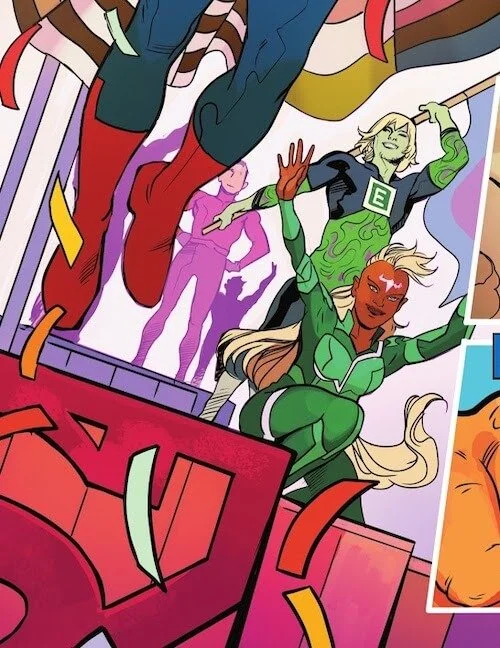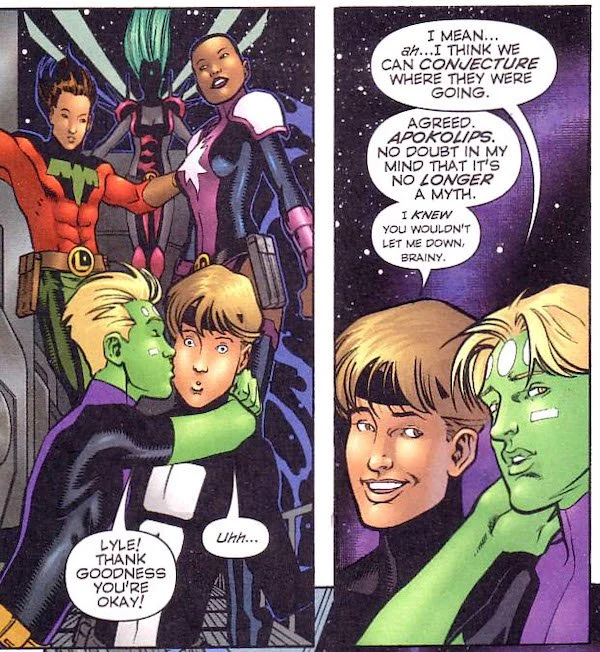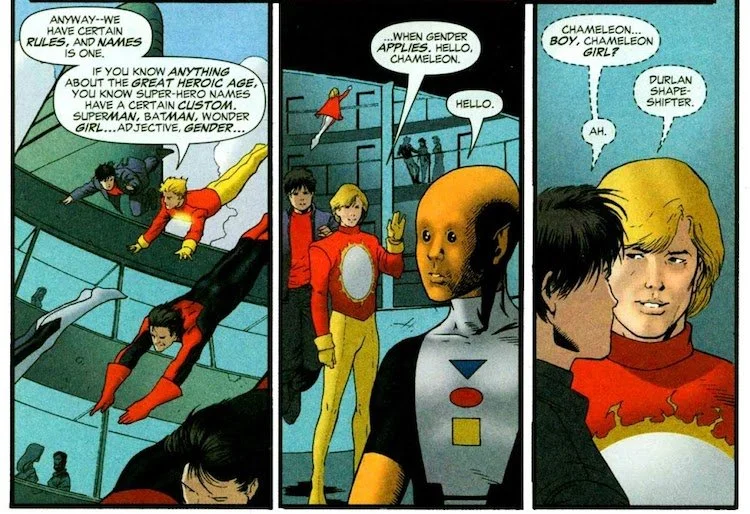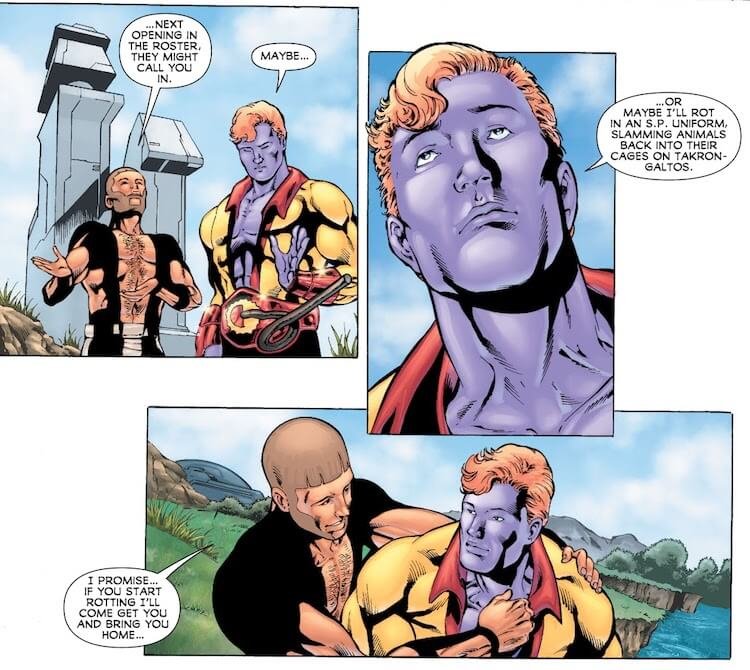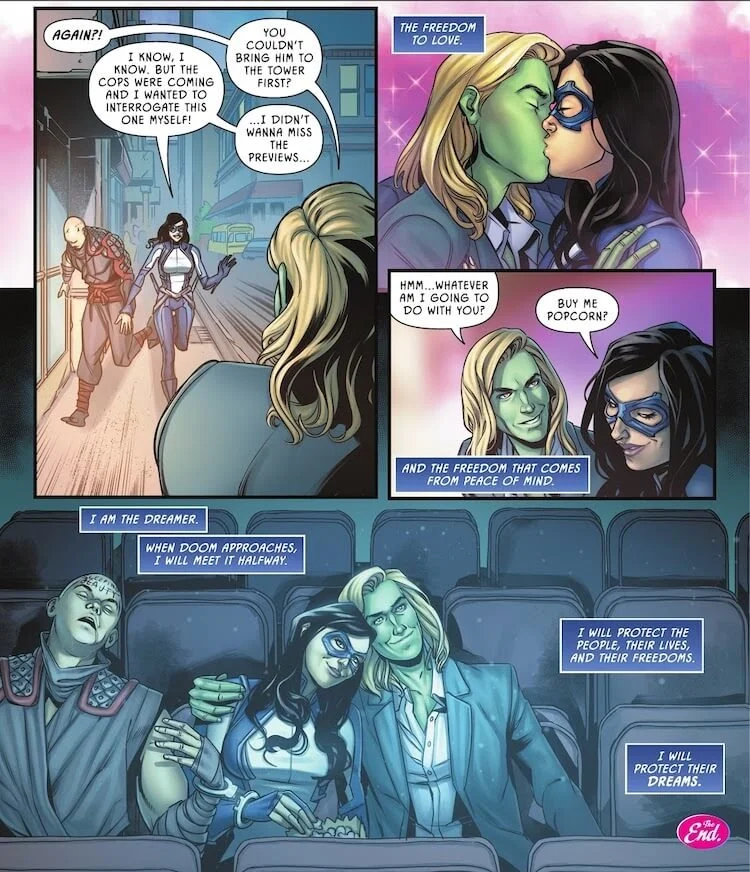Queer Superhero History: The Future Is Gay—Queer Coding in the Legion of Super-Heroes
It’s time for another installment of Queer Superhero History, where we look back at queer characters in mainstream superhero comics, in (roughly) chronological order, to see how the landscape of LGBTQ+ rep in the genre has changed over time. Today: The Legion of Super-Heroes!
The Legion of Super-Heroes is a team of (usually) teenage heroes that first appeared in 1958. They operate a thousand years in the future and are closely associated with Superboy; every version of the character has been a member, as well as Supergirl.
Now fair warning: this is going to be a long one. The Legion has a long history and a huge cast, which means there has been a fair amount of queer coding over the decades, and in more recent years some more explicit queer rep. And let’s be honest…not enough people care about the Legion for me to justify breaking this up into multiple articles. (Sorry, Legion fans.) So let’s get into it!
Element Lad
Element Lad (Jan Arrah) first appeared in Adventure Comics #307 (April 1963) and was created by Edmond Hamilton and John Forte. He has the power to transmute elements and is the last survivor of the planet Trom.
If you look up “comp het” in the dictionary in the 31st century, you’ll find this panel of Light Lass and Element Lad. [Adventure Comics #326 (November 1964), art by John Forte.]
Jan’s queer coding was largely the result of a line in Adventure Comics #326, when he thinks “I’m…er…out of my element when it comes to romancing girls.” It was a throwaway pun, but fans ran with it. Jan being gay was such a popular fan theory that when DC staffers were asked about it during a panel at a convention in 1976, they didn’t confirm it…but they didn’t deny it, either, which was a pretty big deal in those CCA-compliant days.
That same year, a writer listed all the reasons he believed Jan was gay in a Legion fan zine: the lack of interest in girls, the fact that he hadn’t tried to repopulate Trom (so…what does that say about Superman?), his various costumes which were all either pink or boasted prominent crotch-arrows or both, etc. Why does this specific fan theory matter? Well, because the fan in question was Jim Shooter, who had been writing Legion stories for DC since 1966, when he was 14. That’s about as close to official confirmation as could be hoped for in 1976. (And yes, this is that Jim Shooter, who would eventually become editor in chief at Marvel and institute an alleged “no gays in the Marvel universe” policy. Everyone contains multitudes, I guess.)
This fan theory was ignored by a later writer, Paul Levitz, who gave Jan a girlfriend named Shvaughn Erin. We’ve talked about Shvaughn before, but to sum up: in 1992, yet another set of writers (Keith Giffen, Tom Bierbaum, and Mary Bierbaum) revealed that Shvaughn had been born Sean Erin and took medication to transition. Jan was unfazed by this reveal and even implied that he would have preferred Shvaughn as Sean. It’s clumsily handled by modern standards—the writers clearly don’t understand that they are writing a trans woman rather than two gay men—but they were doing their best to fix what they saw Levitz as having broken.
Jan and Shrinking Violet (see below) attend a Pride parade along with Jon Kent’s feet. [DC Pride 2022 (August 2022), art by Nick Robles.]
“I’ve always contended that [Jan] was gay,” Giffen told the fanzine Amazing Heroes in 1989, three years before the Shvaughn/Sean reveal. “It looks like now he’s pretty much heterosexual, although that does disappoint me.” In 2000, both Bierbaums confirmed in the aforementioned Legion fanzine that Jan was gay, and in a 2013 post on his LiveJournal, Tom Bierbaum wrote that he was surprised when he first encountered the gay Jan fan theory, but soon realized that “my vague reservations about gayness were out of step with the real world I was entering…it didn’t take long for me to accept Jan as gay and see more depth to the character.” He also believed Jan and Shvaughn/Sean could have a “stable, healthy relationship since I think they’d evolved into mature, intelligent, caring people.”
Alas, it was not to be. The Legion has been rebooted several times and Jan and Shvaughn’s relationship was erased from continuity, while Jan was given a crush on a (cis) girl in the 2005 Legion run. However, Devin Grayson and Nick Robles included Jan in a Pride parade in DC’s 2022 Pride special, and Jude Deluca, who consulted on the story, suggested that Jan identifies as pansexual, though this isn’t confirmed on-page.
Lightning Lass and Shrinking Violet
Lightning Lass/Light Lass (her codename changes depending on whether she’s using her electricity powers or her gravity powers) debuted in Adventure Comics #308 (May 1963) and was created by Edmond Hamilton and John Forte. She is Ayla Ranzz, from the planet Winath, and her twin brother, Lightning Lad, is one of the founding members of the Legion. Shrinking Violet debuted in Action Comics #276 (May 1961) and was created by Jerry Siegal and Jim Mooney. Her real name is Salu Digby, she’s from the planet Imsk, and, as you’ve probably guessed, she has the power to shrink.
In the late 80s, Ayla and Vi, both recently out of long-running relationships with male characters, suddenly grew a lot closer. Many of their scenes together are genuinely hard to parse if you don’t take the romantic subtext into account, like when Ayla comes on to one of their male teammates and then appears to apologize to Vi for it.
These moments were subtle, but they were enough to make our old friends Tom and Mary Bierbaum already ship the characters when they took over as writers along with Keith Giffen. In the first issue of the 1989 Legion series, after a five year time skip and a sabbatical on her home planet, Vi writes to Ayla to let her know she’s returning to the Legion: “While my MIND is still confused, my HEART now knows EXACTLY where I belong.” They celebrate their reunion with a trip to Ayla’s home planet of Winath, which is clothing optional. That’s not the only suggestive scene: when Vi has her temporary robot leg replaced with a flesh one, she frets about the fact that the new leg is blue (comics, everyone!). Ayla, naked except for a pair of panties, assures Vi that it doesn’t make any difference to her—in fact, it’s kinda cute.
Just gals being pals. [Legion of Super-Heroes #20 (July 1991), art by Keith Giffen and Al Gordon.]
But don’t worry, their relationship isn’t just sexual—in Legion of Super-Heroes #39 (January 1993), Ayla assures Vi that “I always need you. More than anything.” Essentially, they were being written very clearly as a couple—the comics just weren’t saying they were a couple.
But those dang reboots! In 1994, this version of the Legion was erased from continuity, and so was Ayla and Vi’s relationship…until 2010, when the original version of the Legion returned. Ayla and Vi were still not explicitly a couple, but they were very touchy and calling each other “sweetie.” The Legion has been rebooted twice more since, and their relationship status has not been addressed in either reboot. However, Vi did appear in the same 2022 Pride parade as Jan (see above), though her sexuality, like his, was not specified.
Invisible Kid and Chemical King
Invisible Kid, a.k.a. Lyle Norg, debuted Action Comics #267 (August 1960), and was created by Jerry Siegel and Jim Mooney. Unusually for a Legionnaire, he’s from Earth. His power is, well, pretty obvious. Chemical King (Condo Arlik), a much less prominent Legionnaire, was first mentioned in Adventure Comics #354 (March 1967), a story set in the future (uh…the future of the future), as a Legionnaire who had fallen in battle; his real debut came in Adventure Comics #371 (August 1968), and he was created by Jim Shooter and Curt Swan. He can manipulate chemical reactions.
Lyle would go on to die in battle in Superboy and the Legion of Super-Heroes #203 (August 1974), and Condo in #228 (June 1977). It was only years after that the depth of their relationship was revealed, in Secret Origins #47 (February 1990). Here we learned that Condo’s uncontrollable powers led him to be raised in complete isolation…until Lyle, a brilliant scientist, showed up out of nowhere to cure him. He then invites Condo to move in with him and informs him that they’re going to be friends (“a chemical reaction between people”). A deep bond—and lots of homoerotic roughhousing—ensues.
Just boys being pals, too. [Secret Origins #47 (February 1990), art by Chris Sprouse and Al Gordon.]
When Lyle dies, Condo is devastated. He spirals into unreliable behavior, then heroically sacrifices himself to save the world and the Legion. Dying in Brainiac 5’s arms (more on him later), Condo gasps that Lyle changed his life, and that he’s found Lyle after all—Lyle is right here with him. It’s, uh, not subtle.
Both characters were brought back by the 1994 reboot, but Condo was now a civilian reporter and no longer a member of the Legion. Close readers could find extremely subtle hints that they were still in a relationship—like Lyle planning to take a break from the Legion while holding a note signed only by “C” saying “Can’t wait to see you!”—but nothing that came anywhere close to the intensity of that Secret Origins story. According to GayLeague.com, the original post-Zero Hour Legion creators stated that they planned to have a Legionnaire come out as gay, and penciller Jeff Moy confirmed that it was Lyle. (They weren’t the only creative team that interpreted Lyle as gay; Tom Bierbaum did as well, specifically stating in a blogpost that it was due to the Secret Origins story.). But when new creators came on board in 2000, any plans to have Lyle come out were shelved.
I don’t care about Chemical King at all, why am I crying?? [Secret Origins #47 (February 1990), art by Chris Sprouse and Al Gordon.]
Which is why it’s a bit baffling that the 2004 edition of the DC Comics Encyclopedia stated, in Chemical King’s entry: “Arlik has started a low-key relationship with the Legionnaire Invisible Kid,” a thing never confirmed in any actual comic. I personally don’t consider this sort of ancillary material to be strictly canon, but it does go to show the remarkable staying power of this pretty obscure couple and one very, very effective story.
Brainiac 5
Brainiac 5, or “Brainy,” was introduced in Action Comics #276 (May 1961), and was created by Jerry Siegel and Jim Mooney. Querl Dox hails from the planet Colu and is a super-smart descendent (sort of…it’s complicated) of the Superman villain Brainiac.
Brainy’s interest in girls was established in his very first appearance, where he displays an (adorable) crush on Supergirl. This relationship has lasted, off and on and where reboots allow, all the way up to the present day. He’s also been shown having a relationship with Dream Girl and/or Dreamer in various continuities and adaptations.
Nearly 22 years later, I still think this is cute as heck. [The Legion #27 (January 2004), art by Chris Batista, Chip Wallace, and Andy Lanning.]
But after the 1994 reboot, Brainy also developed a…close relationship with Invisible Kid. Most notably, in The Legion #27 (January 2004), after Lyle returns from a dangerous mission, Brainy kisses him on the cheek, and then becomes extremely embarrassed. It sounds silly and chaste now, but I was reading comics by then, and I cannot overstate what a big deal this cheek kiss was to fandom, especially since Lyle was by this point widely understood to be gay. A later issue reveals that Brainy has “a private holo-collection featuring Dreamer, Spark, Andromeda, In—” which is gross, but offers further fodder for Brainy being interested in Lyle, since “Invisible Kid” is the most logical way for that last word to end.
In the aforementioned 2022 Pride special, Brainy was specifically noted to be demisexual, which certainly doesn’t contradict any of his previous relationships. While his interest in boys in general and Lyle in particular always stayed within the realm of subtext, he is canonically queer as of 2022.
Chameleon
Chameleon, a.k.a. Reep Daggle (god, I love Legion names), was originally introduced as Chameleon Boy in Adventure Comics #267 (August 1960) alongside Invisible Kid, and was also created by Jerry Siegel and Jim Mooney. Like everyone from the planet Durla, they are a shapeshifter. In the 1994 reboot, when everyone got cooler codenames, they dropped the “Boy” and just started going by “Chameleon.”
More importantly, in the 2005 reboot (sigh), the Legion officially has a rule that every codename must follow the Adjective + Gender formula (Element Lad, Light Lass, etc.)...“when gender applies,” which it does not to Chameleon. “Chameleon…Boy, Chameleon Girl?” a new Legionnaire asks upon being introduced to Reep. “Durlan shape-shifter,” Sun Boy responds, and that appears to be answer enough. This makes Reep chronologically the first Legionnaire to be explicitly queer in the text, rather than relegated to decades of subtext.
It boggles my mind that DC ever undid this. What is the point, beside catering to fans in their 50s and older? [Legion of Super-Heroes #1 (February 2005), art by Barry Kitson.]
Unfortunately…you already know where this is going…the Legion was rebooted yet again a few years later, or rather de-booted, and the original character was brought back as Chameleon Boy, a status that has held ever since. Come on, DC. This is such an easy fix.
Dawnstar
Dawnstar (which is both her real name and codename) debuted in Superboy and the Legion of Super-Heroes #226 (April 1977). A descendent of the Pueblo peoples of Earth, she comes from the planet Starhaven and has wings which she can use to fly at light speed.
In the Bronze Age, Dawnstar had a long-running relationship with fellow Legionnaire Wildfire, but it was by necessity chaste, since he is an energy being in a containment suit. Being a future space teen is tough!
I’m mostly including these panels so that you can actually see what Dawnstar looks like. For the record, though comics have a long history of extremely racist coloring of Indigenous characters, I think this is just a bad scan—I’ve seen less high-res versions of this page online that aren’t nearly this…fuchsia. [Legion of Super-Heroes #38 (September 1987), art by Greg LaRocque, Mike DeCarlo, and Arne Starr.]
In 2007, the original incarnation of the Legion traveled to the 21st century on a mission. Various members of the JLA attempted to track them down, and in Justice League of America #9 (July 2007), several Leaguers chase a lead to the planet Thanager, where they find not Dawnstar, but an unnamed woman with Dawnstar’s Legion ring. “Her ring…her promise that she would come back to me. She and I—she said she’d come back,” the woman says.
Is this text or subtext? I vote text, but it’s admittedly a gray area. [Justice League of America #9 (July 2007), art by Ed Benes.]
It’s extremely clear in this brief exchange that this woman and Dawnstar were lovers, making Dawnstar the second canonically queer Legionnaire. However, it wasn’t explored further—not so much due to censorship as to Dawnstar’s queerness being a passing mention about a minor character in an unreadably bad story. (Sorry, but it’s true.) Dawnstar would barely appear again, let alone be acknowledged as queer, until the aforementioned 2022 DC Pride anthology, which confirms her to be bisexual.
Power Boy and Gravity Kid
Power Boy (Jedidiah Rikane) debuted in Superboy and the Legion of Super-Heroes #240 (June 1978) by Paul Levitz and Jim Sherman. He appeared a handful of times to no very great importance, then disappeared for decades.
Levitz returned to the Legion in 2010, and in Legion of Super-Heroes #6 (December 2010), he and artist Phil Jimenez (notably, one of the first out comic book creators in mainstream comics) introduced Power Boy’s boyfriend, Gravity Kid (Tel Vole).
There is a probably a dissertation to be written about how overtly sexual the costumes of the Legion’s only canon gay couple are, especially Gravity Kid’s (which, to be fair, is inspired by an iconic and even skimpier costume worn by major and ostensibly straight Legionnaire Cosmic Boy). If you write it, please send it to me so I can read it. [Adventure Comics (September 2011), art by Geraldo Borges, Ransom Getty, Marlo Alquiza, and Rob Hunter.]
Unlike Legionnaires in previous eras, Jedidiah and Tel didn’t have to navigate through subtext, or even the stilted language and suggestive ellipses Dawnstar’s girlfriend was stuck with just three years prior. They embrace on page, they’re shown sharing a bedroom, and when Jedidiah joins the Science Police, Tel says he’ll follow him via a “trailing spouse” position, which might mean they’re actually married.
As this entire series of articles has probably made very obvious, I love me an obscure queer character. That said, I’m not sure anyone but Paul Levitz actually cares about these two; Gravity Kid has a whopping 11 appearances, none more recent than 2013. But I think they make an interesting bridge between Dawnstar, with her just barely textual queerness, and our next chronologically queer Legionnaire, Dreamer, an actual protagonist.
Dreamer
Like other notable comic book characters such as Jimmy Olsen and Harley Quinn, Dreamer first debuted in a superhero adaptation: specifically, the “American Alien” episode of Supergirl, which first aired on October 14, 2018. She was played by Nicole Maines, and is the first trans superhero on television. Her first comics appearance came in the 2021 Pride anthology, in a story written by Maines and drawn by Rachael Stott. She was quickly folded into the main DC universe and has continued to appear regularly. She also starred in Bad Dream: A Dreamer Story, a 2024 graphic novel by Maines and Rye Hickman, and though this technically doesn’t take place in the main DCU, Dreamer’s comics backstory is consistent across both.
In all universes, Dreamer (Nia Nal) is from the planet Naltor and has precognitive powers. Technically, she’s not a Legionnaire, since she exists in the present day rather than the future; instead she’s the ancestor of Nura Nal, the classic Legionnaire Dream Girl. However, she’s strongly associated with the Legion, so I think she fits here.
They are very cute but please, Brainy, cut your hair. [DC Pride 2021 (August 2021), art by Rachael Stott.]
Unlike most of the characters on this list, Dreamer has never been relegated to subtext; the fact that she was going to be introduced as the first trans superhero on TV was announced at SDCC in July 2018, three months before her debut. She’s never had her identity confirmed via euphemism or rebooted away. And unlike Power Boy and Gravity Kid, she’s not a forgotten Z-lister (sorry, Power Boy and Gravity Kid); in three short years, she’s headlined on two different team books and starred in her own graphic novel. She even has her own messy situationship with Jon Kent, Superman’s son. I wouldn’t say she’s A-list, but she’s a significant player, and usually a well-written one. (Much of that writing is by Maines, who is a shockingly excellent comic book writer as well as a successful actress and activist. Talk about a triple threat!)
The Legion is a franchise DC has struggled with in recent decades; their fanbase is rooted in their 70s-80s heyday, and the constant reboots and un-boots has left their continuity an unapproachable tangle for new readers. They don’t even have a book right now, though as of this writing an evil version of them is guest-starring in Superman. Two of their most recent reboots, 2005 and 2019, have made half-hearted attempts at diversifying the cast, mostly via racebending, but have largely ignored the team’s historical queer subtext.
Brainy and Dawnstar are confirmed as demi and bi, respectively, in the aforementioned 2022 Pride special. [DC Pride 2022 (August 2022), art by Nick Robles.)
If DC wants to bring in newer, younger Legion readers, I think embracing the various queer and trans members of the lineup would help shake some of the Legion’s reputation as being old stories for old fans. They’ve even got their digital comics line, DC Go!, with multiple queer leads like Jon Kent (a Legionnaire himself!) and Jackson Hyde. It’s honestly baffling to me that Warlord has a DC Go! comic and the Legion doesn’t. DC, what are you doing?
Oh well. Maybe someday we’ll get the queer future utopia we deserve, both in reality and at DC Comics. Until then: long live the Legion!

